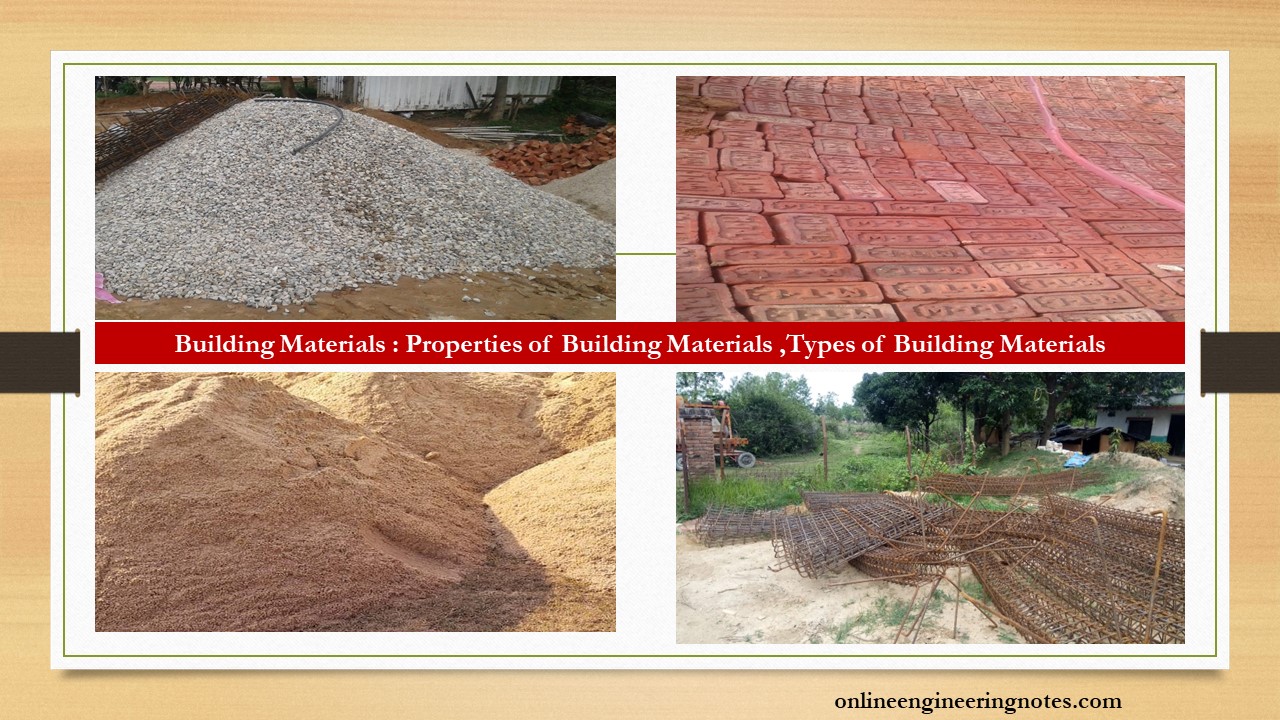Properties of Building Materials
Physical Properties: Identified by visual observation & Hand tools
Chemical Properties: Identified based on the effect of different chemicals
Thermal Properties: Effect of Heat
Types of Building Materials
Stone
Stone is the naturally available construction material and is obtained from a quarry, process of extracting stones by excavating, wedging, heating & blasting is called quarrying and is composed of different minerals and with different processes.
Classification of stones:
Geological Classification:
Igneous Rocks
- Solidification of molten mass above or below the earth’s surface.
- Crystalline glossy or fussed texture
- Ex: – Granite, Basalt, Diorite, Trap dolerite, Syenite, Pegmatite, Gabbro etc.
Sedimentary Rocks
- Gradually deposition of sand, clay, debris, etc. by the action of rain, wind, sun etc.
- Stratified
- Ex: – limestone and sandstone, conglomerate, gypsum, dolomite, magnesite, chalk, shale, kankar,Tripoli, diatomite, etc.
Metamorphic Rocks
- Change in texture or mineral composition of rocks under heat and excessive pressure
- Ex: – marble, Gneiss, Quartzite, Slate, Schist, etc.
Physical classification:
Stratified Rocks:
- Distinct layers which can be separated
- E.g.: limestone, slate, and sandstone.
Unstratified Rocks:
- No sign of strata
- E.g.: granite, marble, etc.
Chemical classification:
Silicious Rocks
- Silica as the main constituents
- E.g.: granite, quartzite, gneiss etc.
Argillaceous Rocks
- Clay or Alumina as main constituents
- E.g. of silicious rock: slate, laterite, kaolin, etc.
Calcareous Rocks
- Lime or calcium
- E.g.: limestone, marble, etc.
Important building stones:
1. Granite
- mainly composed of quartz, felspar, mica
What is Feldspar?
“Feldspar is no other than silicate of aluminum with varying amounts of potash, soda, or lime.
- Sp. Gravity -= 2.64
- Compressive strength = 70 – 130 MN/m2
- color depends on felspar – brown, grey, green, pink
- Offer high resistance to weathering
- Easily polished and worked
- Used for the external facing of buildings
2. Slate
- Argillaceous rock
- Alumina + sand /carbonate of lime
- Sp. Gravity = 2.8
- Compressive strength = 60-7- MN/m2
- Grey/dark blue color
- Hard, tough, fine-grained
- Used in cisterns
- Slate as tiles, an excellent roof covering material.
3. Gneiss
- Gneiss:
- A silicious rock
- Composed of quartz and felspar
- More easily worked than granite
- Used for street paving
4. Sandstone
- Silicious sedimentary rock.
- Composed of quartz, lime, and silica
- Sp. Gravity = 2.65- 2.9
- Compressive strength = 35 -40 MN/m2
- White, grey, brown, pink, etc.
- Strong and durable
- Used for ashlar works, moldings, carvings, etc.
5. Limestone
- Sedimentary rock of calcareous variety
- Sp. Gravity = 2.6
- Brown, yellow, dark grey colors
- Used large quantities in blast furnaces
- Used as stone masonry for walls.
6. Marble
- Metamorphic rock of calcareous variety
- Sp. Gravity = 2.7
- Very hard, ornamental work, takes a fine polish
- Carving, decoration
- Kankar
- Impure limestone containing 30 % alumina & silica
- Used for foundations of buildings
7. Laterite
- Laterite contains a high percentage of iron oxide.
- Porous and cellular structure
- Sp. Gravity = 2 -2.2
- Laterite blocks are suitable for light roads, and inferior buildings.
- a very good road metal
8. Moorum
- Decomposed laterite
- Deep brown or red color
- Used in garden walks & paths
9. Quartzite
- Siliceous sandstones
- Strong, durable, used as road metal/ railway ballast
Bricks
Bricks are construction materials made by moulding the tempered clay to a suitable shape and size which is in a plastic condition, dried in sun, and burnt in a kiln or clamp.
Brick clay contains (20-30) % Alumina
(50-70) % Silica
Other constituents are lime, magnesia, sodium, potassium, manganese, and Iron oxide.
Excess of Alumina,Silica & Lime
Alumina – brick crack/warp on drying
Silica – brick brittle and weak
Lime – brick to melt and distort during burning
Alkaline salt – efflorescence
Manufacture of Bricks:
Preparation of Brick clay
- Earth left for atmospheric action for a few weeks after digging called weathering.
- 1.5 – 2.5 m3 of brick soil – 1000 bricks
- Tempered in pug mills
- Process of mixing clay, water, and other ingredients is known as Kneading.
Moulding bricks:
- Handmade bricks superior to machine-made bricks
- Drying of Bricks:
- Bricks are arranged in rows on their edges on a slightly raised ground called hacks.
- Burning of bricks:
- Clamp burning = 60 % out-turn
- Kiln burning = 80 – 90 % out-turn
- Takes 24 hrs. at 1000 – 1200 0c.
- Cool for 12 days
Classification of Bricks:
1. First Class:
- Well burnt, smooth, even surface, rectangular, uniform reddish.
- Water absorption (≤ 20 %) at 24 hrs.
- Min. crushing strength = 10.5 MN/m2
2. Second Class:
- Slightly overburnt, rough, no perfect rectangle
- Water absorption (≤ 22 %)
3. Third Class:
- Under burnt, soft, easily broken
- Water absorption (≤ 25 %)
4. Jhama bricks
- Over burnt, irregular, dark bluish color
What is the size of the Brick?
- Size of Brick = (19 cm * 9 cm * 4 cm)
Or (19 cm * 9 cm * 9 cm)
- Sp. Gravity = 2
- For 1 m3 of brick masonry = 550 machine-made bricks
500 handmade bricks
Special Bricks:
Squint bricks: construction of acute and obtuse squint quoins
Paving bricks: used for street pavements
Round bricks: circular pillars
Perforated & Hollow: Partitions walls
Refractory Bricks: withstanding temperature, low Coeff. of expansion & contraction.
- Acid Bricks: (fire Bricks & silica bricks)
- Basic Bricks: ( Dolomite bricks, Magnesite bricks and bauxite bricks)
- Neutral Bricks: (Chrome bricks, chrome-magnesite Bricks, spinel Bricks)

